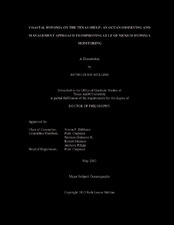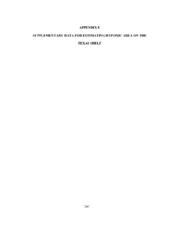| dc.description.abstract | A combination of in situ sampling and real-time ocean observations was used to investigate the processes responsible for the formation and the areal extent of Texas coastal hypoxia from 2002 to 2011. In situ sampling, real-time mooring and buoy observations, and multivariate statistical modeling were used to investigate the physical processes driving hypoxia formation. Geostatistical interpolation (ordinary kriging) models were tested to compare the differences in annual hypoxia area on the Texas shelf. Results from these two sections were integrated into recommendations for improving federal hypoxia monitoring and mitigation strategies in the northwestern Gulf of Mexico.
Winds, currents, temperature, salinity, and dissolved oxygen records revealed the annual, seasonal, and daily variability of hypoxia formation on the Texas coast from 2009 to 2011. Hypoxic events occurred from late May to late October lasting from hours to weeks. Hypoxia formation was either the result of salinity stratification, associated with the freshening of surface waters by the advection of Mississippi-Atchafalaya River freshwater westward or the wind- and current-driven upcoast or downcoast flow of Brazos River discharge. Records from 2010 and 2011 showed the variability and frequency of stratification development differs on the north and south Texas shelf. Multivariate linear model results showed contributing factors on the north Texas shelf vary annually and that primary factors for hypoxia development are near-surface current speeds and salinity-driven stratification.
Interpolation models resulted in three size categories for hypoxia area: small (100 – 1,000 km^2), moderate (1,001 – 3,000 km^2), and large (3,001+ km^2). Moderate years include 2002, 2004, and 2007 and a large year was 2008. There was no increase in hypoxic area from years 2002 to 2011, but years 2007 and 2008 resulted in a hypoxic area over 5,000 km^2, which is the federally mandated hypoxia reduction target for the northwestern Gulf of Mexico. Geostatistical interpolators represent and predict the structure and spatial extent of the hypoxic area on the Texas shelf by accounting for the anisotropy of physical processes on the Texas shelf. Geostatistical interpolation models are preferred to deterministic models for developing and improving federal hypoxia monitoring and mitigation strategies on the northwestern Gulf of Mexico shelf. | en |



